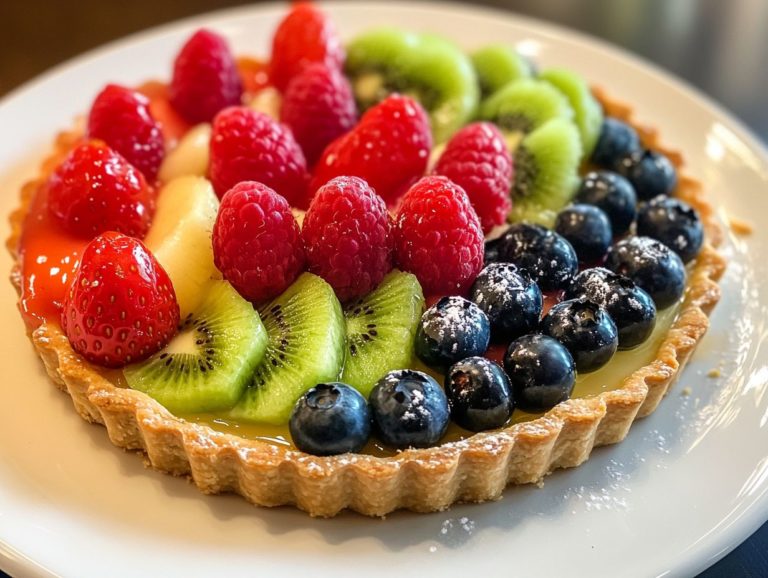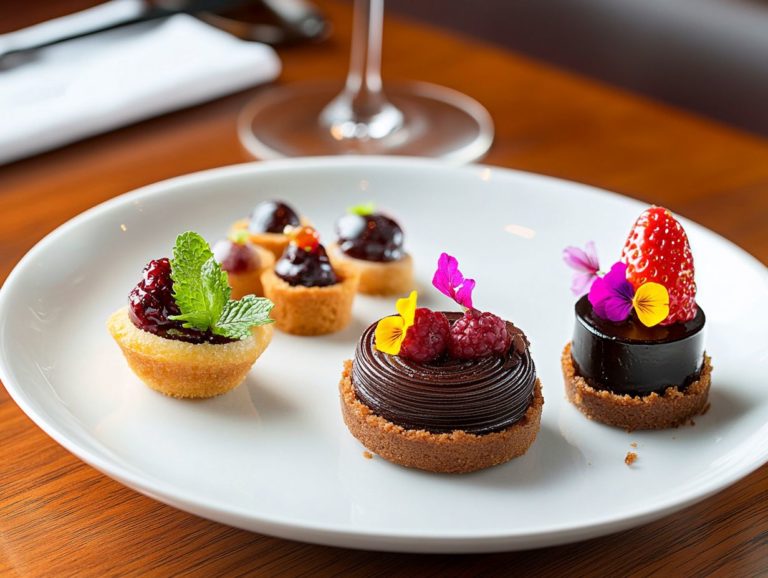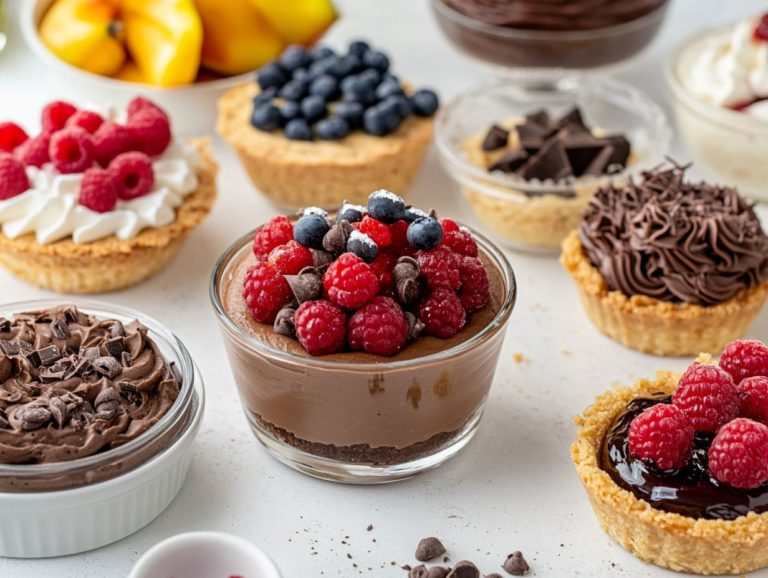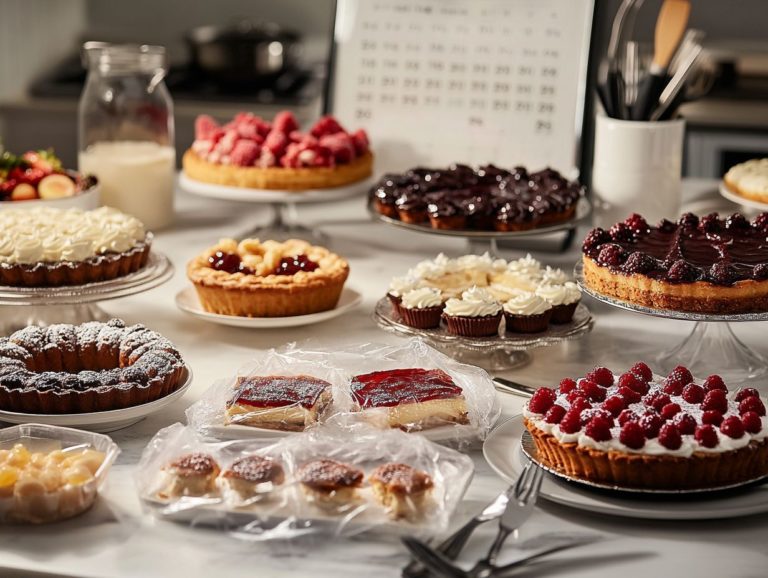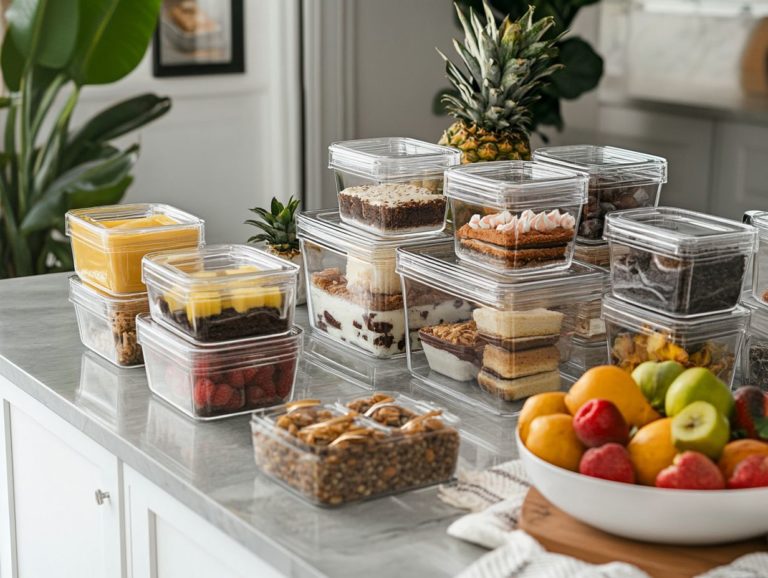What Are the Best Types of Chocolate for Desserts?
Chocolate is an exquisite ingredient that has the power to elevate desserts from the mundane to the sublime. With its rich flavors and remarkable versatility, chocolate can transform any sweet indulgence into a great dessert.
In this article, you ll discover the different types of chocolate, explore their key ingredients, and learn which varieties are best suited for your dessert creations. You ll also find expert tips on selecting the perfect chocolate and utilizing it effectively, ensuring that your treats are not only delicious but also visually captivating.
Get ready to satisfy your sweet cravings with incredible chocolate treats!
- Key Takeaways:
- What Makes Chocolate Good for Desserts?
- What are the Best Types of Chocolate for Desserts?
- Selecting the Right Chocolate for Your Desserts
- Tips for Using Chocolate in Desserts
- 4. Experiment with Different Types of Chocolate
- Frequently Asked Questions
- What Are the Best Types of Chocolate for Desserts?
- What is the difference between dark, milk, and white chocolate?
- Can I use any type of chocolate in my desserts?
- Which type of chocolate is best for baking?
- Are there any health benefits to eating dark chocolate desserts?
- Can I substitute one type of chocolate for another in a dessert recipe?
- Dark chocolate is the best option for rich and decadent desserts as it has a higher percentage of cocoa and less sugar.
- For a sweeter and creamier dessert, milk chocolate is the way to go, but be mindful of its lower cocoa content.
- White chocolate may not be considered “real” chocolate, but it adds a creamy and sweet touch to desserts when used in moderation.
- Bittersweet chocolate offers depth and complexity, making it ideal for sophisticated chocolate desserts.
- Ruby chocolate, with its unique fruity flavor and pink hue, can add an exotic twist to your sweet creations.
- Blonde chocolate, also known as caramelized white chocolate, provides a butterscotch-like flavor perfect for gourmet chocolate recipes.
Contents
Key Takeaways:
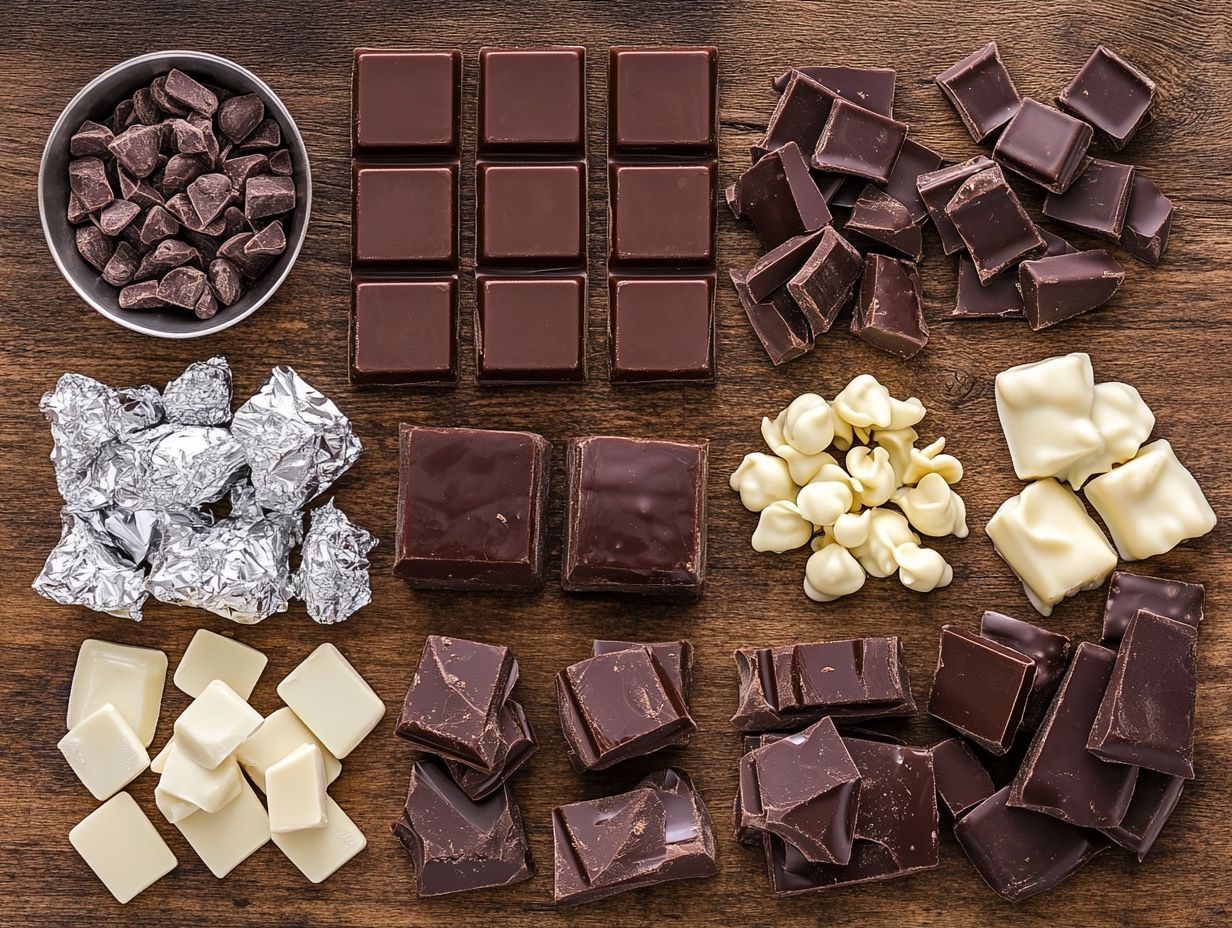
What Makes Chocolate Good for Desserts?
Chocolate stands as a versatile and cherished ingredient in the realm of desserts. It captivates the hearts of chocolate enthusiasts around the world. Its rich flavors and textures elevate an array of sweet delights, making it a critical element in crafting exquisite chocolate recipes.
Whether you are using dark chocolate, milk chocolate, or even couverture chocolate, each type offers its own charm and utility in the kitchen. You can indulge in classic chocolate chip cookies or explore sophisticated chocolate desserts. The various types of chocolate milk chocolate, dark chocolate, and white chocolate cater to an array of taste preferences.
Chocolate options like semisweet, bittersweet, and even ruby chocolate offer distinctive flavor profiles and textures, transforming any dessert into a gourmet experience. For anyone aspiring to become a true chocolate connoisseur, grasping the significance of the seed from which chocolate is made and cocoa powder in these recipes is essential.
What are the Different Types of Chocolate?
Chocolate presents a delightful array of types, each boasting its unique flavor profiles and culinary uses. It’s essential for you as a dessert enthusiast to grasp these distinctions.
Take milk chocolate, for instance. Its creamy sweetness and velvety texture are ideal for mousses and luscious sauces. In contrast, dark chocolate brings a rich, bittersweet complexity that enhances indulgent roasts and decadent brownies.
Semisweet chocolate shines brightly in beloved classics like chocolate chip cookies, where its perfect balance of sugar and cocoa earns universal adoration. For a more adventurous take, try incorporating ruby chocolate into your recipes for a unique flavor twist.
Even white chocolate, though it lacks cocoa, excels in harmonizing with flavors like raspberry or lemon, resulting in refreshing desserts that delight the palate. As you venture into more specialized varieties, bittersweet chocolate can elevate your ganaches or truffles, adding a layer of depth to your flavor profiles.
Additionally, couverture chocolate is ideal for achieving that perfect glossy finish in your chocolate confections. Consider selecting high-quality brands like Valrhona and Guittard, as opting for chocolate with a higher cocoa percentage can significantly enhance the taste and texture of your culinary creations.
What are the Key Ingredients in Chocolate?
The key ingredients that compose chocolate are essential in shaping its flavor, texture, and overall quality, which are crucial for creating exquisite chocolate desserts. From the richness of chocolate liquor to the smoothness provided by cocoa butter, understanding these elements is vital for any chocolate connoisseur.
At the core of chocolate lies cacao, the building block from which everything else emerges. The beans are transformed into various forms, including chocolate liquor, which serves as the foundation for all types of chocolate. Cocoa butter, derived from the fat of cacao beans, gives chocolate its smooth melting quality, while cocoa powder delivers the rich chocolate flavor that enhances countless recipes. Cacao nibs, those delightful pieces of crushed cacao beans, introduce a satisfying crunch and depth, making them a favorite among gourmet cooks and chocolate aficionados alike. Additionally, natural cocoa powder, as opposed to Dutch process cocoa, can offer a more robust chocolate flavor in your recipes.
Each of these elements, sourced from high-quality cacao, plays a significant role in your tasting experience. For example, expertly harvested beans from sustainable farms can elevate the chocolate’s flavor profile, offering unique notes that vary by origin. When you re diving into chocolate desserts, the quality of the cocoa butter is equally crucial; its purity guarantees a silky mouthfeel that beautifully complements delicate pastries and mousses.
Incorporating fresh, unprocessed cocoa powder can amplify the dessert’s taste, making it richer and more indulgent. Meanwhile, cacao nibs not only add an appealing texture but also contribute a natural bitterness that balances sweetness, crafting a luxurious and complex chocolate experience that delights your palate. For a sweeter alternative, German sweet chocolate can be an excellent choice for various baked goods.
What are the Best Types of Chocolate for Desserts?
When selecting the finest types of chocolate for your desserts, grasping the flavor profiles and characteristics of each variety can profoundly elevate your culinary creations.
Dark chocolate, celebrated for its rich and intense flavor, is an exceptional choice for gourmet desserts, infusing depth and sophistication into cakes and mousses.
If you lean towards creamy sweetness, milk chocolate is perfect for indulging in classic desserts like brownies and various chocolate treats. Don t overlook white chocolate; it offers a delightful sweetness that pairs beautifully with fruits and spices, adding a unique twist to your dishes.
Semisweet chocolate, a staple in baking recipes like chocolate chip cookies, provides an ideal balance of taste and texture. For those with a more refined palate, bittersweet chocolate, with its higher cacao content, can truly elevate your desserts.
And let s not forget couverture chocolate, the darling of professional bakers, known for its exceptional melting qualities and luxurious finish in chocolate confections.
1. Dark Chocolate
Dark chocolate is often regarded as the ultimate choice for discerning chocolate lovers who savor its deep, rich flavor and impressive health benefits. With a higher cacao percentage, dark chocolate not only enhances that bittersweet taste you adore but also provides a generous dose of antioxidants, making it a delightful addition to your chocolate desserts. For those interested in exploring new chocolate varieties, The Pioneer Woman suggests trying different chocolate flavors to expand your palate.
The cacao content in dark chocolate typically falls between 60% and 99%, with higher percentages offering bolder flavors and a less sugary experience. If you’re new to chocolate baking, starting with natural cocoa powder can help you achieve rich and intense flavors in your desserts.
Renowned chocolatiers like Lindt, Ghirardelli, and Green & Black s present a range of options, each boasting unique tasting notes that might surprise your palate from fruity to nutty. If you appreciate a brighter, more complex taste, a 70% cacao dark chocolate could be your perfect match. For those who crave a deeper, earthier profile, chocolates with 85% cacao or more will likely capture your attention.
In terms of crafting delectable recipes, incorporating dark chocolate into timeless desserts like brownies, mousse, or even chocolate bark can elevate your culinary creations, allowing those rich, luxurious flavors to shine through in every bite. Don’t forget to experiment with melting chocolate techniques to achieve the perfect consistency for your chocolate section in any dessert.
2. Milk Chocolate
Milk chocolate is celebrated for its creamy texture and delightful sweetness, making it your go-to choice in countless chocolate bars and desserts. This type of chocolate is crafted with milk powder or condensed milk, lending a smooth mouthfeel and rich flavor profile that appeals to those who enjoy a lighter chocolate experience.
Its versatility truly shines in various dessert recipes. From the indulgent milk chocolate mousse to decadent brownies, this beloved ingredient adds an extra layer of richness. If you re ready to melt milk chocolate for drizzling or dipping, brands like Ghirardelli and Lindt offer high-quality options that maintain their consistency and flavor even when heated.
Whether you’re using it as a fondue base or blending it into a creamy ganache for cakes, quality milk chocolate elevates every aspect of your dessert creations. Vanessa Greaves, a well-known culinary expert, often recommends premium milk chocolate for its superior melting properties.
Want perfectly melted chocolate? Use a double boiler or microwave it in short bursts to prevent it from becoming lumpy. These tips ensure that delectable results are within reach for both novice and seasoned bakers alike. For specialized needs, candy coating chocolate can also be a versatile choice, especially for dipping and coating purposes.
3. White Chocolate
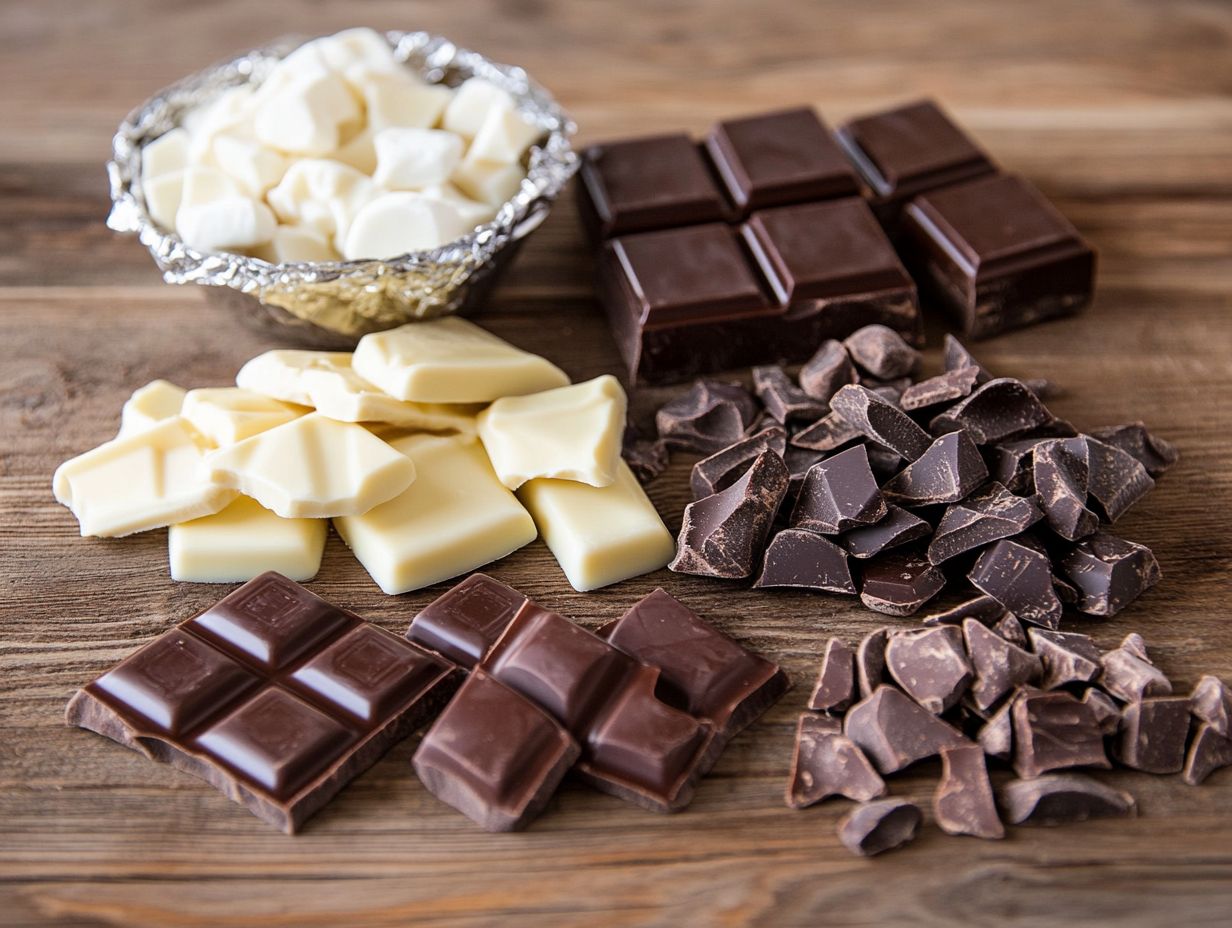
White chocolate, often regarded as the unconventional cousin of traditional chocolate, is crafted primarily from cocoa butter, sugar, and milk solids, resulting in a sweet and creamy flavor profile. While it may lack cocoa solids, it presents a delightful alternative for those who find darker chocolates a bit too intense making it a cherished ingredient in a variety of chocolate desserts.
This delightful confection has the power to elevate an array of baked goods, from cookies to cakes, infusing each bite with a velvety sweetness that captivates the palate. Blonde chocolate, with its caramel-like notes, can also be a fantastic addition to your baking repertoire.
For those who enjoy chocolate f ves, they can be a luxurious addition to your baking recipes. When you re baking, white chocolate harmonizes beautifully with flavors like vanilla, citrus, and even spices such as cinnamon, enhancing the overall taste experience.
Consider exploring creative recipes like white chocolate raspberry cookies or lemon and white chocolate scones, which truly showcase its versatility and charm. To achieve the finest results, it s crucial to choose high-quality white chocolate, characterized by a high cocoa butter content and minimal additives. This ensures a rich, authentic flavor that shines brilliantly in your baked creations. Try using brands like Chocolove or Valrhona to elevate your desserts.
4. Semi-sweet Chocolate
Semi-sweet chocolate is a remarkable ingredient that can elevate your baking game, especially in beloved recipes like chocolate chip cookies or when using chocolate chunks in a variety of desserts. Its perfect balance of sweetness and richness truly shines, with about 60% cocoa content, making it an ideal choice for a wide array of dessert creations.
This chocolate s rich profile enhances everything from brownies to cakes, delivering a deep, satisfying flavor that bakers adore. When you’re melting semi-sweet chocolate, take your time: opt for a double boiler or use short bursts in the microwave to prevent it from becoming lumpy. Consider experimenting with types like couverture chocolate, which has a higher cocoa butter content, ideal for coating and enrobing, for even better results.
If you want to achieve a glossy finish on your confections, mastering proper tempering techniques, a method used to melt chocolate smoothly, can enhance the chocolate s shine and give it that delightful snap. Don’t hesitate to experiment with variations, such as pairing semi-sweet chocolate with dark or white chocolate.
This can introduce exciting new dimensions to your favorite treats, transforming every bite into a delightful surprise.
Try out these delicious recipes today and elevate your dessert game!
Selecting the Right Chocolate for Your Desserts
Choosing the right chocolate is the secret to crafting desserts that burst with flavor and texture. It all starts with understanding your personal palate and the specific needs of your recipe.
Each type of chocolate whether it s the rich depth of dark chocolate, the creamy sweetness of milk chocolate, or the delicate notes of white chocolate brings its own unique qualities to the table, capable of elevating a simple dessert into something truly extraordinary.
5. Bittersweet Chocolate
Bittersweet chocolate is truly a treasure, known for its rich flavor and elevated cocoa content, making it an exceptional choice for crafting indulgent chocolate desserts. Whether you’re whipping up ganaches or decadent cakes, bittersweet chocolate brings a depth of flavor that perfectly balances with sweeter ingredients.
This remarkable quality renders it particularly adept at enhancing the overall taste profile of pastries, mousses, and even cookies. When you incorporate bittersweet chocolate into your recipes, you not only achieve a luscious texture but also introduce an intriguing contrast that elevates your dessert experiences.
Its versatility allows it to shine in both classic and contemporary creations, ranging from silky-smooth truffles to elaborate layered cakes. The nuanced flavor notes infuse warmth and sophistication, making it a favorite among bakers and chefs who appreciate its ability to enchant the palate. It harmonizes beautifully with nuts, fruits, or even spices, creating a well-rounded dessert that is not only satisfying but also unforgettable.
6. Couverture Chocolate
Couverture chocolate is a luxurious type of chocolate, celebrated for its high cocoa butter content, which gives it that silky and glossy finish when tempered just right. If you’re aiming for professional-grade baking and chocolate coatings, this is your go-to choice, effortlessly elevating desserts like truffles and bonbons to a whole new level of sophistication. Consider using couverture from brands like Valrhona or Chocolove.
Tempering this chocolate enhances both its texture and your dessert’s presentation, making them visually stunning and utterly irresistible.
If you’re eager to incorporate couverture chocolate into your baking adventures, starting with a double boiler for melting will grant you precise temperature control. Aim to bring the chocolate to about 115 F, then let it cool to around 82 F before gently reheating it to 88-90 F for that perfect working temperature. For more tips, check out expert advice from Vanessa Greaves.
This technique maximizes the shiny finish and helps achieve that satisfying crisp snap in your finished confections. Whether you’re dipping luscious fruits or crafting intricate decorations, using tempered couverture chocolate allows you to showcase your artistic flair while delivering a truly indulgent taste experience.
7. Cocoa Powder
Cocoa powder is a critical ingredient in your baking repertoire, offering a rich, concentrated chocolate flavor while playing a vital role in achieving the ideal texture for your cakes and brownies. With various forms available, including Dutch process cocoa and natural cocoa powder, each type brings its own unique flavor profile and acidity levels, which can significantly influence the final result of your chocolate desserts.
Understanding these differences is important to improve your recipes. Natural cocoa powder typically presents a sharper, more acidic flavor owing to its processing method, whereas Dutch process cocoa is alkalized, delivering a smoother, milder taste.
This alkalization alters how these powders interact with other ingredients, such as baking soda or baking powder. When you incorporate them into your recipes, ensuring the correct pairing of cocoa type with the appropriate leavening agents is vital for achieving a well-balanced rise. For instance, using natural cocoa with baking soda can amplify the leavening effect, while Dutch process cocoa pairs more effectively with baking powder, resulting in the optimal texture and flavor for your baked creations.
What Flavor Profile Do You Want?
Choosing the right chocolate starts with understanding your flavor preferences. Each type of chocolate offers unique levels of sweetness, richness, and depth.
If you lean toward a sweeter experience, milk chocolate or semi-sweet chocolate might be just what you need. However, if you prefer a more intense chocolate flavor, dark or bittersweet chocolate is likely to be your go-to.
Beyond the main types, there are intriguing flavor notes to explore. Take white chocolate, for example. Although it isn t technically chocolate because it lacks cocoa, its rich, creamy sweetness beautifully complements citrus desserts like tartlets or panna cotta.
Then there are flavored chocolates, infused with chili or sea salt, which can transform ordinary brownies into gourmet delights by adding unexpected layers of complexity.
When crafting your desserts, balancing flavors is key. Pairing dark chocolate with a hint of lavender can create a sophisticated bite that elevates your treat. A pinch of salt can work wonders, enhancing sweetness while deepening the chocolate’s flavor.
Don t hesitate to experiment with flavor contrasts; these explorations can lead to delightful discoveries, ensuring each dessert resonates perfectly with your personal taste. Explore the diverse chocolate types available to find the perfect match for your palate.
Consider the Cacao Percentage
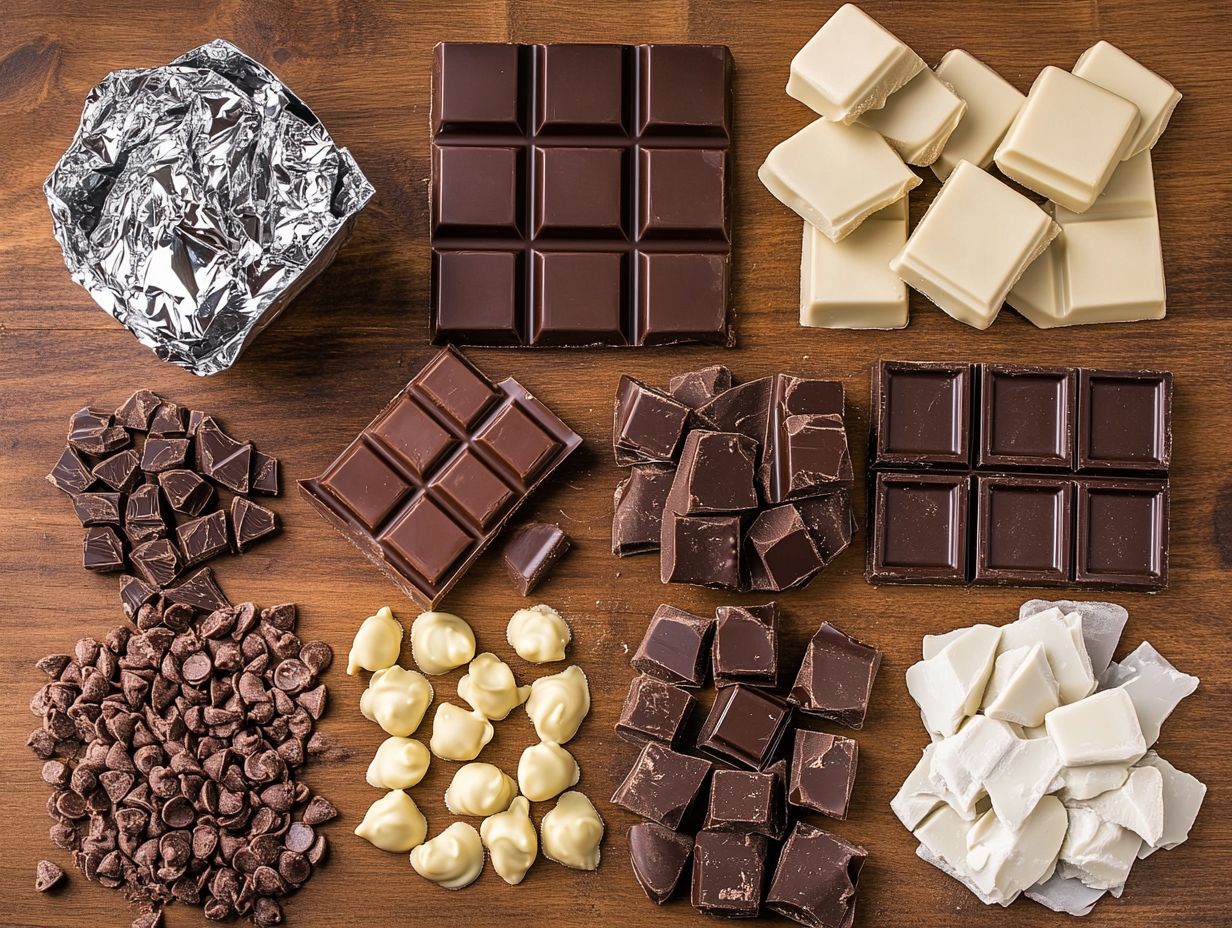
The cacao percentage in chocolate plays a critical role in shaping the flavor intensity and overall quality of your desserts, making it a vital factor to consider when choosing chocolate for your recipes.
A higher cacao percentage typically produces darker, richer flavors, which are perfect for gourmet creations. In contrast, lower percentages offer a sweeter, creamier taste that’s ideal for treats like chocolate chip cookies.
This variation in flavor can dramatically transform your final product, providing you with a vast canvas for cooking creativity. For instance, a chocolate mousse crafted with high cacao content will deliver an intense and complex taste, while one made with lower cacao will lean towards a lighter, airier experience.
If you’re aiming to strike a balance between bitterness and sweetness in your confections, it’s essential to consider how the cacao ratio interacts with other ingredients.
Ultimately, by understanding these cacao percentages, you’ll be empowered to select the perfect chocolate that enhances the unique characteristics of the desserts you wish to create. Whether you’re using cooking chocolate or specialty options like German’s sweet chocolate, the right choice can make all the difference.
Pay Attention to the Quality of Ingredients
The quality of ingredients you choose for your dessert, particularly the type of chocolate, can truly make or break the final product. This is why investing in premium chocolate is essential for achieving superior results.
By selecting high-quality chocolate, such as couverture chocolate or gourmet brands, you elevate the taste and texture of your desserts, transforming them from ordinary to extraordinary. Check out recipes from experts like The Pioneer Woman for inspiration.
When you re baking, it s vital to pay attention to the chocolate’s cocoa content. The cocoa content greatly influences flavor. It s important to choose wisely!
Aim for brands that offer a high percentage of cocoa solids ideally above 70% to ensure a rich and intense chocolate flavor. Be vigilant about the ingredient list; quality chocolate typically contains minimal additives or artificial flavors.
Whenever you can, opt for brands that use sustainable cacao sources. Not only does this support ethical practices, but it often leads to a better-tasting chocolate as well. By making these thoughtful choices, you can significantly enhance your homemade treats, leaving friends and family impressed with your bakery-quality creations.
Make these choices today to elevate your desserts instantly!
Now that you know how to choose the best chocolate, it s time to start baking! Experiment with different flavors and creations to impress everyone.
Tips for Using Chocolate in Desserts
Utilizing chocolate in desserts can elevate both the flavor and presentation. Embracing a few key tips ensures that your chocolate treats achieve perfection every time. Whether you’re using baking chocolate or chocolate baking bars, the quality significantly impacts the final outcome.
First and foremost, always choose high-quality chocolate. It s essential for imparting richness and depth of flavor to your creations. Whether you’re using a rich chocolate used for coating desserts or German sweet chocolate, mastering the techniques for melting chocolate and knowing how to pair it with complementary flavors can transform your desserts into something extraordinary.
1. Use High-Quality Chocolate
Using high-quality chocolate is absolutely essential for achieving the best flavor and texture in your desserts and profoundly influences the overall outcome of your culinary creations. Premium chocolate brands like Chocolove and Valrhona are celebrated for their superior sourcing and meticulous production methods. They elevate the flavor profile, ensuring your chocolate desserts are indulgent and unforgettable.
Choose chocolate with high cocoa content for rich flavors. It typically melts delightfully. Quality chocolate should possess a smooth texture and a glossy sheen, which indicate proper tempering and minimal additives.
Renowned chocolate makers like Valrhona, Callebaut, and Ghirardelli have earned their reputations through a steadfast commitment to quality and craftsmanship. They are excellent choices for both home bakers and professional chefs.
It’s crucial to examine the ingredient list. Seek out chocolate that contains minimal ingredients, primarily cocoa solids, cocoa butter, and sugar. By understanding and recognizing these characteristics, you can elevate your chocolate-based creations to unparalleled heights.
2. Don’t Overheat Chocolate
One of the most essential tips for working with chocolate is to avoid overheating it. Excessive heat can lead to seized or burned chocolate, ruining the texture and flavor of your desserts. Employ safe melting techniques. Using a double boiler or a microwave set to lower power settings allows you to achieve a smooth and velvety consistency without compromising quality.
When you use a double boiler, ensure the water doesn t touch the bottom of the bowl containing the chocolate. This indirect heat provides gentle heat for melting. If you choose the microwave route, heat in short bursts of 20-30 seconds, stirring in between, to ensure even melting. For those who prefer, using Dutch process cocoa can add a rich flavor to your recipes without requiring melting.
For tempering, heat the chocolate to a specific temperature and then cool it gradually to stabilize it, resulting in a beautiful glossy finish. If you encounter common issues like chocolate seizing, adding a small amount of fat, such as vegetable oil or cocoa butter, can work wonders to restore its texture.
3. Pair Chocolate with Complementary Flavors
Excitingly, pairing chocolate with complementary flavors can elevate your desserts to new heights! Ingredients like vanilla, sea salt, fruits, and nuts work beautifully with various types of chocolate. They enhance the overall flavor experience and add depth to your creations.
For instance, rich dark chocolate often pairs exceptionally well with the brightness of citrus fruits like orange or raspberry, while silky milk chocolate shines alongside sweet caramel or toasted almonds. If you re feeling adventurous, consider incorporating herbs like rosemary or mint to introduce an intriguing freshness that contrasts with the richness of the chocolate.
When crafting desserts, maintaining balance is key. Too much sweetness from the chocolate or clashing flavors can easily overwhelm the dish. Experimenting with these pairings sparks your creativity and ensures that each bite offers a delightful experience, highlighting the nuanced flavors of chocolate.
4. Experiment with Different Types of Chocolate
Experimenting with different types of chocolate opens the door to delightful discoveries. You can transform traditional recipes into unique desserts that showcase a broader spectrum of flavors and textures.
By incorporating varieties like blonde chocolate, semisweet chocolate, couverture chocolate, and even gianduja, you can create innovative desserts that will surprise and delight even the most discerning chocolate lovers!
But why stop there? The joy of baking with chocolate invites you to infuse spices such as cinnamon or chipotle for a daring twist that makes your desserts even better. Imagine whipping up a rich dark chocolate mousse. It s perfectly enhanced with a splash of orange zest for that refreshing surprise.
You could also consider crafting a layered cake that alternates between white chocolate and dark chocolate ganache, allowing each bite to reveal a tantalizing new flavor dimension.
This adventurous approach encourages you to explore the countless possibilities within the world of chocolate and inspires you to redefine your dessert experience.
Frequently Asked Questions
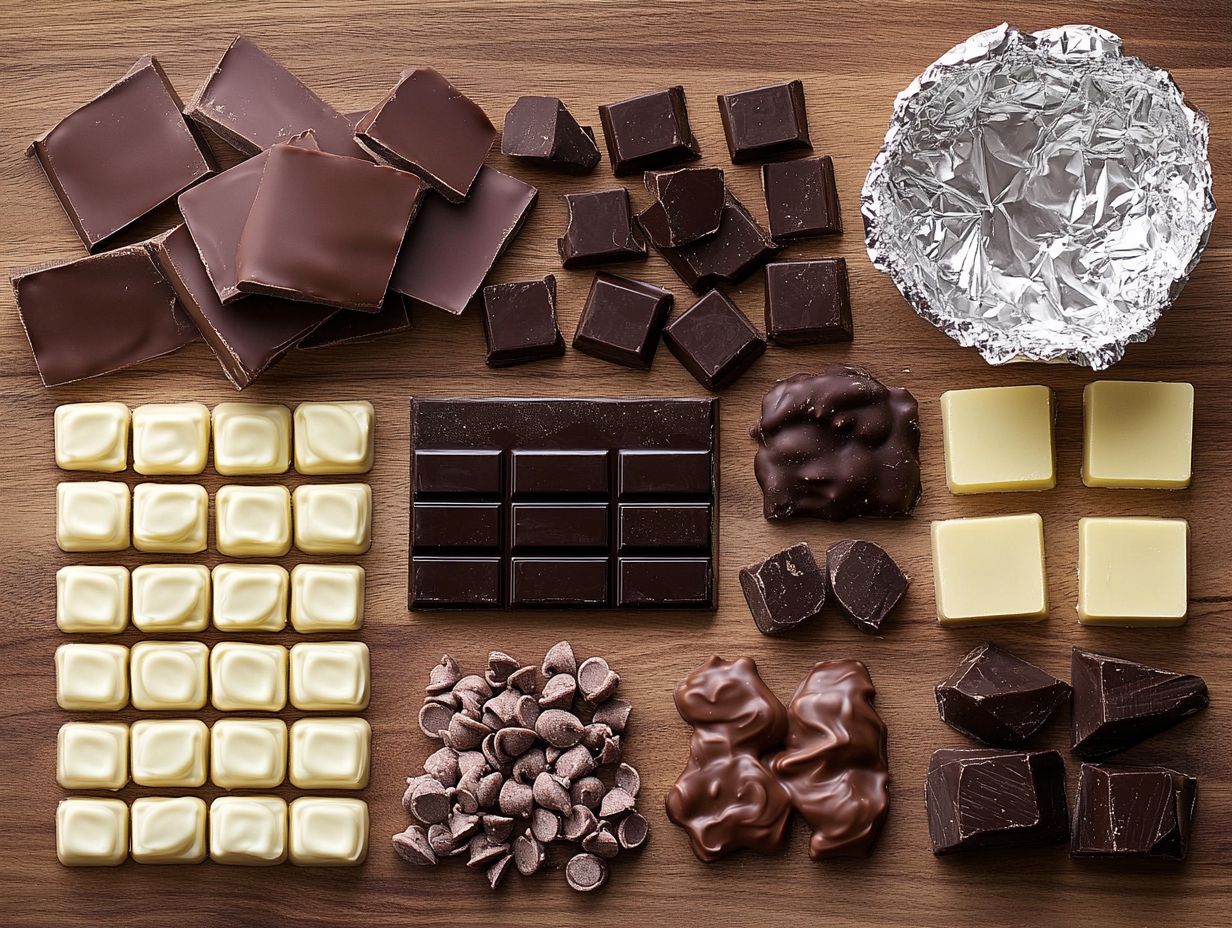
What Are the Best Types of Chocolate for Desserts?
Some of the best types of chocolate for desserts include couverture chocolate for its superior melting quality and German sweet chocolate for a milder, sweeter taste. The best types of chocolate for desserts are dark chocolate, milk chocolate, and white chocolate.
What is the difference between dark, milk, and white chocolate?
Dark chocolate has a higher cocoa content and is less sweet than milk or white chocolate. Milk chocolate contains more milk and sugar, giving it a creamier texture and sweeter taste. White chocolate does not contain any cocoa solids, only cocoa butter, making it the sweetest of the three.
Can I use any type of chocolate in my desserts?
Yes, you can use any type of chocolate in your desserts. However, the type of chocolate you use will affect the flavor and texture of your dessert. It is best to use the type of chocolate specified in the recipe for the best results.
Which type of chocolate is best for baking?
Dark chocolate is typically the best for baking as it has a higher cocoa content and adds a more intense chocolate flavor to baked goods. However, milk chocolate and white chocolate can also be used in certain recipes.
Are there any health benefits to eating dark chocolate desserts?
Yes, dark chocolate contains antioxidants and may have health benefits when consumed in moderation. However, the amount of sugar and fat in the dessert should also be taken into consideration. Vanessa Greaves from The Pioneer Woman often emphasizes the importance of balance in her recipes to make them healthier.
Can I substitute one type of chocolate for another in a dessert recipe?
In most cases, yes, you can substitute one type of chocolate for another in a dessert recipe. Just keep in mind that the flavor and texture of the dessert may be slightly altered. It is always best to use the type of chocolate specified in the recipe for the best results.
So why wait? Get started on your chocolate adventure today!


